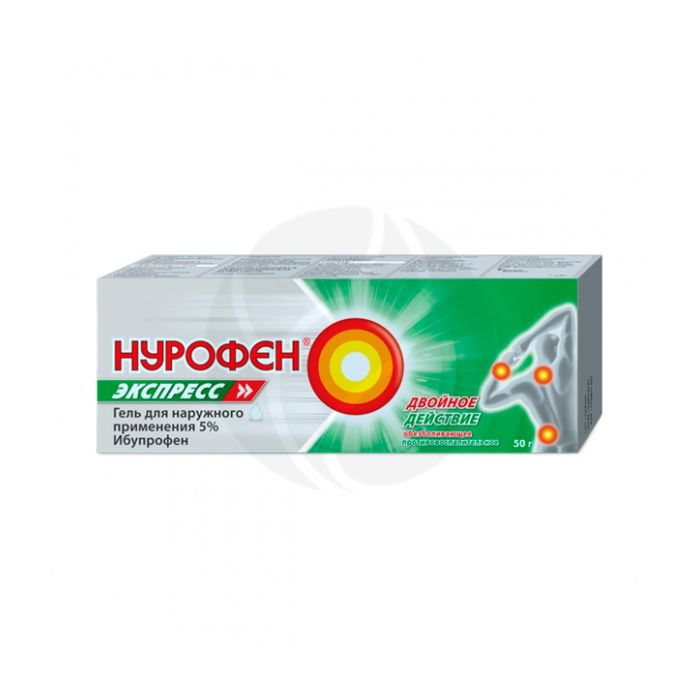Nurofen Express gel 5%, 50 g
Expiration Date: 11/2025
Russian Pharmacy name:
Нурофен Экспресс гель 5%, 50 г
As a local anesthetic and anti-inflammatory agent for conditions such as
muscle pain;
backache;
arthritis;
pain with ligament injuries and sprains;
sports injuries and neuralgia.
Outwardly.
Read the instructions carefully before using the drug.
NurofenЃ Express Gel is prescribed for adults and children over 14 years of age. When using the tube for the first time: after opening the lid, check that the protective foil on the neck of the tube is not damaged.
Open the foil by pressing on it with the outside of the lid.
Squeeze 4-10 cm of the drug (equivalent to approximately 50-125 mg ibuprofen) from the tube onto your hand and gently rub the gel into the skin until completely absorbed.
Wash your hands immediately after using the drug. The drug should be reused no earlier than after 4 hours. The gel should not be used more than four times within 24 hours. The maximum daily dose is 500 mg.
If symptoms persist or worsen within 2 weeks of using the drug, discontinue treatment and consult a doctor. Do not exceed the indicated dose.
100 g of gel contains active substance: ibuprofen 5 g
excipients: hyethylose 1.8 g, sodium hydroxide QS (0.93 - 1 g), benzyl alcohol 1 g, isopropanol 5 g, purified water 86.2 g.
- Hypersensitivity to ibuprofen or other components that make up the drug.
- A history of hypersensitivity reactions (bronchial asthma, rhinitis, Quincke's edema, urticaria) in response to the use of acetylsalicylic acid or other NSAIDs.
- Violations of the integrity of the skin at the site of application of the drug (including infected abrasions and wounds, weeping dermatitis, eczema).
- Children up to age 14.
- Pregnancy III trimester.
Pharmacology.
The drug belongs to the group of non-steroidal anti-inflammatory drugs (NSAIDs). It has a double effect: analgesic and anti-inflammatory. Ibuprofen, being a propionic acid derivative, indiscriminately blocks cyclooxygenase 1 (COX-1) and cyclooxygenase 2 (COX-2), as a result of which it inhibits the synthesis of prostaglandins - mediators of pain, inflammation and hyperthermic reaction. When applied to the skin, the gel has an additional cooling effect due to the rapid evaporation of benzyl alcohol contained in the composition.
Pharmacokinetics:
Once applied to the skin, ibuprofen is found in the epidermis and dermis after 24 hours. The maximum plasma concentration of ibuprofen when applied topically is 5% of the maximum concentration when using oral forms of ibuprofen. Virtually no clinically significant systemic absorption occurs. It is metabolized in the liver. It is excreted by the kidneys (not more than 1% unchanged) and, to a lesser extent, with bile.
Carefully:
If you have the conditions listed in this section, you should consult a doctor before using the drug. Bronchial asthma or allergic diseases in the acute stage or in history - possible development of bronchospasm, renal failure, liver failure, stomach ulcer, including a history of enteritis, colitis, hemorrhagic diathesis, pregnancy I-II trimester, breastfeeding period, chickenpox smallpox.
Special instructions:
Avoid contact with eyes, lips and other mucous membranes, damaged skin. Do not use in combination with an occlusive (sealed) medical dressing. Avoid excessive exposure to sunlight on the area of ??application of the drug. The use of NSAIDs in patients with chickenpox may be associated with an increased risk of developing severe purulent complications of infectious and inflammatory diseases of the skin and subcutaneous fat (for example, necrotizing fasciitis). In this regard, it is recommended to avoid the use of the drug for chickenpox.
Side effect:
The following adverse reactions were observed with short-term use of ibuprofen at a dose not exceeding 500 mg / day. In the treatment of chronic conditions and with prolonged use, other adverse reactions may occur.
- Immune system disorders
Frequency unknown: hypersensitivity reactions
- nonspecific allergic reactions and anaphylactic reactions, reactions from the respiratory tract (bronchial asthma, including its exacerbation, bronchospasm, shortness of breath, dyspnea), skin reactions (itching, urticaria, purpura, Quincke's edema, exfoliative and bullous dermatoses, including toxic epidermal necrolysis (Lyell's syndrome), Stevens-Johnson syndrome, erythema multiforme).
- Disorders from the gastrointestinal tract
Frequency unknown: abdominal pain, dyspepsia.
- Renal and urinary tract disorders Frequency unknown: renal dysfunction.
If side effects appear, you should immediately stop using the drug and consult a doctor.
Overdose:
The likelihood of accidental overdose with the gel preparation is minimal. In children, symptoms of overdose may occur after ingestion of a dose exceeding 400 mg / kg body weight. In adults, the dose-dependent effect of overdose is less pronounced. The half-life of the drug in case of overdose is 1.5-3 hours. If the drug is accidentally taken by mouth, the following symptoms may occur: headache, vomiting, decreased blood pressure. Treatment: gastric lavage (only within an hour after ingestion), intake of activated charcoal, alkaline drinking, forced diuresis, symptomatic therapy.
Interaction with other medicinal products:
Use with caution simultaneously with the following drugs:
Х Anticoagulants and thrombolytic drugs,
Х Antihypertensive drugs,
Х Acetylsalicylic acid,
Х other NSAIDs.
It should be borne in mind that even with topical application of ibuprofen, its systemic effect cannot be completely excluded and, theoretically, with the simultaneous use of ibuprofen gel with other NSAIDs, side effects may increase.

